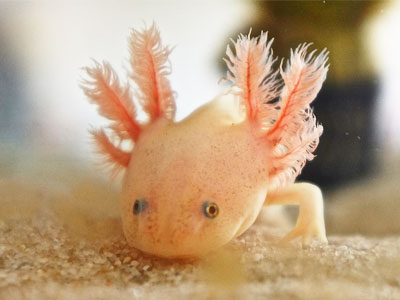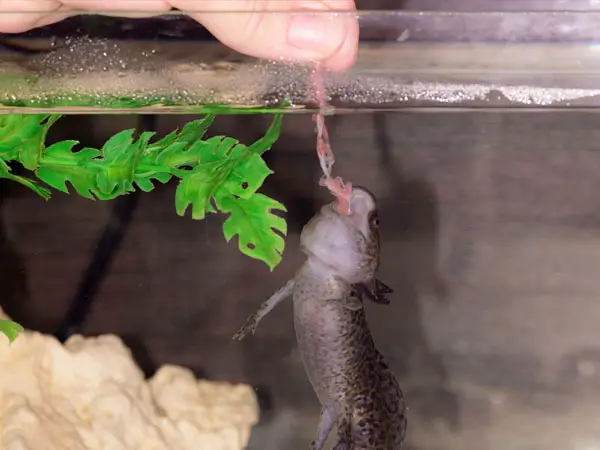In the axolotl diet, superworms fall into the occasional treat category. In general, it is not a bad idea to surprise your axolotl with something unusual. You just need to make sure that the treat in question is not a high-fat food and that it’s something meat-based.

After all, axolotls are carnivores and they prefer to eat meat all the time. Meat provides them with the energy they need throughout the day. Although superworms are not exactly the highest quality of meat, they are acceptable but you can’t feed it to them all the time.
Moreover, feeding your axolotl superworms is not the safest idea either. You need to know exactly how to prepare them because they can do a lot of damage. In this article, we are going to explain everything you need to know about superworms as axolotl food.
Are Superworms Good for Axolotls?
In terms of nutritional value, superworms leave much to be desired. On top of that, they have a very hard exoskeleton. It takes a lot of time for that exoskeleton to go through your axolotl’s digestive system. But first off, you need to make sure that worm fits into his mouth.
Axolotls have very few teeth and they are not sharp either. The way they eat is they suck the food in and swallow it right away. This is why it is important to offer your axolotl food in proportion to its size. It can’t be too big because then it will cause difficulties with swallowing and maybe even impaction.
Superworms also bite and they can do a lot of damage to the soft body of an axolotl. It is a crucial preventive measure to crush or remove their heads. You can do so with various tools that can be found at home, such as a tweezer or scissors.
Can Axolotls Eat Superworm Adults or Pupa?
There is a lot of nutrition in superworm larvae and they are an outstanding choice for exotic pets. Their exoskeleton is not as hard, so it is easy to swallow and digest. If you are looking for an absolute energy bomb for your axolotl, then definitely get some superworm larvae.
When comparing larvae with adults and pupa, it turns out that the exoskeleton of adults and pupa are much harder. They go really hard on the digestion of your axolotl, which is why you probably shouldn’t feed them to your pet. They can cause impaction and your salamander might not even be able to swallow them.
How Often to Feed Superworms to Axolotls?
Superworms not only bite but their exoskeleton can cause choking and impaction. If you feed axolotls superworms with their exoskeleton on, sometimes it can be fatal. This depends on the size of the worm and how lucky your axolotl was at swallowing and digesting it.
Therefore, this is a risk you shouldn’t take. There are plenty of other treats to choose from that are much healthier for axolotls. However, you can also feed them superworms without the exoskeleton. After all, they don’t always have it on. Sometimes they need to shed their exoskeleton and develop a new one.
This happens multiple times throughout their larval stage. You can get a lot of superworm larvae and check back on them until you find a few that are lighter in color. It is easy to tell that they have just got rid of their hard exoskeleton.
Grabbing those soft larvae and feeding them to your axolotl is a much better way to go about it. No digestive problems, no health risks. But still, superworms are not the ideal source of nutrition for axolotls. You still need to consider them a treat and feed them to your pet once or twice a month.
Can Axolotls Eat Dried Superworms?
In live superworms, there is at least some moist that can help with the digestion. The problem with dried worms is that those hard layers are even harder. It is very difficult to digest to any other animal, not only for the axolotl. Not to mention that it comes with little nutritional value so it’s not even worth it.
Superworms are already hard to digest so you need something that makes it easier, not harder. For example, chopping those worms into smaller pieces definitely helps. But in the end, what helps the most is to be patient with superworm larvae and wait until they shed their exoskeleton.
Your axolotl is going to be happy to eat those soft worms. It also introduces something new to the menu.
Can Baby Axolotls Eat Superworms?
There are simply too many problems with superworms as axolotl food. They are too hard with that exoskeleton, too dangerous with their strong bite and too big for a baby axolotl. Superworms should be considered as emergency food for adult axolotls when you really can’t find anything else at home.
What axolotl babies need are small, protein-rich worms that are soft, easy to digest and can easily fit in their mouth. Even mealworms, the smaller relatives of superworms are too big for those babies. Fortunately, there are plenty of cheap, nutritious options when it comes to feeding them.
Wrapping Up
We are not saying that axolotls can’t eat superworms, but it is not the best idea nutritionally and safety-wise either. If you feel like giving your axolotls a treat or superworms are the only food you can find at home, then you can feed it to them.
Just don’t skip the preparation process because it can cost the life of your precious pet. Those worms have a strong bite and they can easily bite through the soft body of an axolotl. First things first, crush their head. Then, make sure the worm is small enough for your axolotl to swallow.
Most adult axolotls should be able to swallow it. If you can manage to feed them some superworm larvae without the exoskeleton, then it’s probably the best option. Hopefully, we have answered all your questions about superworms as salamander food.




